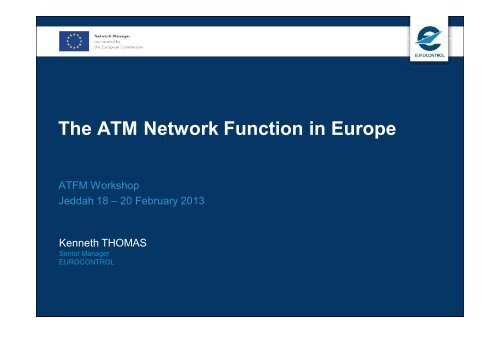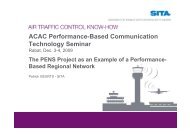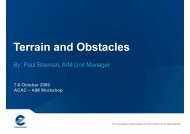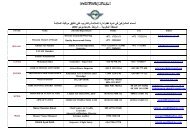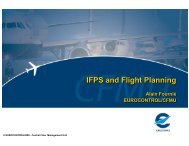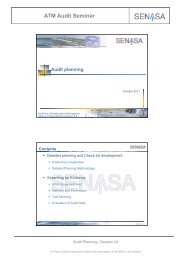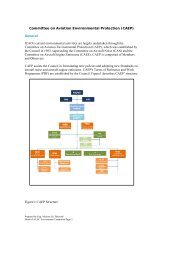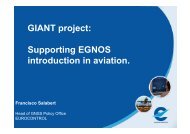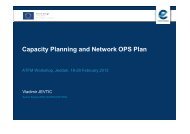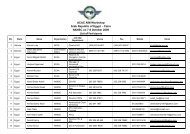The ATM Network Function in Europe
The ATM Network Function in Europe
The ATM Network Function in Europe
Create successful ePaper yourself
Turn your PDF publications into a flip-book with our unique Google optimized e-Paper software.
<strong>The</strong> <strong>ATM</strong> <strong>Network</strong> <strong>Function</strong> <strong>in</strong> <strong>Europe</strong><br />
ATFM Workshop<br />
Jeddah 18 – 20 February 2013<br />
Kenneth THOMAS<br />
Senior Manager<br />
EUROCONTROL
Back <strong>in</strong> the 1980s:<br />
Major <strong>Europe</strong>an <strong>ATM</strong> crisis: Creation of CFMU<br />
London<br />
Creation 5 regional units<br />
Doesn’t<br />
work<br />
ATFM system<br />
One central unit:<br />
CFMU +<br />
Local FMP<br />
Paris<br />
Frankfurt<br />
1988 CFMU is created.<br />
EUROCONTROL will<br />
implement and operate it<br />
Madrid<br />
Rome<br />
<strong>ATM</strong><br />
Delays<br />
1996 CFMU<br />
fully operational<br />
1980<br />
1990<br />
27/02/2013 2
In the early 80’s several<br />
Flow Management Units<br />
were created to cope with<br />
<strong>in</strong>creas<strong>in</strong>g congestion<br />
But the organisation was<br />
<strong>in</strong>efficient and the delays<br />
skyrocketed end of the<br />
80’s<br />
27/02/2013 3
<strong>The</strong> <strong>Europe</strong>an Central<br />
Flow Management Unit<br />
was created and became<br />
operational <strong>in</strong> 1995<br />
27/02/2013 4
CFMU is the first <strong>Europe</strong>an <strong>Network</strong> <strong>Function</strong><br />
‣ Central service<br />
‣ Central <strong>in</strong>frastructure<br />
For all <strong>Europe</strong><br />
27/02/2013 5
Air Transport – Air Navigation - <strong>Europe</strong><br />
EUROCONTROL<br />
ICAO: <strong>The</strong> contract<strong>in</strong>g States recognize that every<br />
State has complete and exclusive sovereignty over<br />
the airspace above its territory.<br />
• Service Providers (ANSP): 39<br />
• Area Control Centres (ACC): 64<br />
• Sectors at full capacity: 670<br />
• Towers +/- 430<br />
• Approach units 220<br />
• Air Traffic Controllers* 16.800<br />
• Support staff 40.000<br />
-------------------------------------------------------<br />
Total Employees 56.000<br />
B€ 3/ATCO<br />
B€ 1/<strong>in</strong>vestment<br />
B€ 4/support (operat<strong>in</strong>g and other staff)<br />
Total B€ 8/year<br />
* 60% ACC; 40% APP/TWR<br />
27/02/2013 6
A <strong>Europe</strong>an view over the operations<br />
<strong>ATM</strong> Structure <strong>in</strong> <strong>Europe</strong><br />
One s<strong>in</strong>gle Flow Management System over <strong>Europe</strong><br />
41 States<br />
1750 Sectors & 64 enroute centres<br />
1348 Aircraft Operators<br />
450 Airports<br />
61 FMPs<br />
<strong>Network</strong> Operations<br />
+4,000 connected end-users<br />
Peaks +34,400 Flights a day<br />
+10,000,000 Flights a year<br />
27/02/2013 7
S<strong>in</strong>gle <strong>Europe</strong>an Sky (SES)<br />
• End of 1990s another crisis <strong>in</strong> <strong>ATM</strong><br />
• Madame De Palacio Commissionner<br />
launched<br />
the S<strong>in</strong>gle <strong>Europe</strong>an Sky<br />
SES created <strong>in</strong> 2004<br />
27/02/2013 8
S<strong>in</strong>gle <strong>Europe</strong>an Sky II<br />
‣ <strong>The</strong> Performance Scheme safety cost-efficiency, capacity and environment.<br />
‣ <strong>The</strong> <strong>Function</strong>al Airspace Blocks bottom-up <strong>in</strong>itiatives enhanced cooperation between the<br />
(ANSPs) and the national supervisory authorities (NSAs) to de-fragment the airspace<br />
‣ <strong>The</strong> <strong>Network</strong> Manager is a centralised function at EU level to carry out the management of<br />
the <strong>ATM</strong> network functions (airspace design, capacity plann<strong>in</strong>g flow management)<br />
• and management of scarce resources (transponder code allocations,radio frequencies)<br />
‣ <strong>The</strong> Charg<strong>in</strong>g Regulation transparent report<strong>in</strong>g of en-route charges and costs' components<br />
of the Member States.<br />
• legal basis for f<strong>in</strong>anc<strong>in</strong>g, through the charg<strong>in</strong>g system, of the "Common Projects" <strong>in</strong> the<br />
context of the deployment of SESAR.<br />
27/02/2013 9
Performance achievement<br />
is the key driver<br />
of SES<br />
Enter here your presentation title 27/02/2013 10 10
EU-wide targets adopted for 2012-14<br />
Safety<br />
To monitor : 2012-2014<br />
<strong>Europe</strong>an safety network KPI : 2015-<br />
2019<br />
4,0%<br />
3,5%<br />
3,0%<br />
Environment<br />
Environment target<br />
5,0%<br />
Reduce 4,5% route extension by<br />
2004<br />
2005<br />
% of horizontal en route extension<br />
2006<br />
2007<br />
0.75%<br />
2008<br />
2009<br />
2010<br />
2011<br />
2012<br />
2013<br />
2014<br />
-0.75%<br />
po<strong>in</strong>ts<br />
vs.<br />
2009<br />
compared to 2009<br />
Actual basel<strong>in</strong>e<br />
EU-wide target<br />
Current enhancement plans (-0.6% po<strong>in</strong>ts vs. 2009)<br />
1,5<br />
Capacity<br />
Delay/capacity target<br />
En route ATFM delay per flight (m<strong>in</strong>.)<br />
Cost-efficiency<br />
Determ<strong>in</strong>ed unit rates (DUR)<br />
Cost efficiency target<br />
1,3<br />
1,0<br />
0,8<br />
0,5<br />
0,3<br />
0,0<br />
Reduce ATFM delays<br />
to 0.5 m<strong>in</strong><br />
2004<br />
2005<br />
2006<br />
2007<br />
2008<br />
2009<br />
2010<br />
2011<br />
2012<br />
2013<br />
2014<br />
Actual basel<strong>in</strong>e Current EUROCONTROL target<br />
Current capacity plann<strong>in</strong>g EU-wide target<br />
0.5 m<strong>in</strong>.<br />
2010 figure was 2.0 m<strong>in</strong><br />
€ 2009<br />
/SU<br />
66<br />
64<br />
Reduce average E-U wide<br />
determ<strong>in</strong>ed unit rate from<br />
59.97 € <strong>in</strong> 2011<br />
62<br />
60<br />
58<br />
56<br />
54<br />
52<br />
50<br />
48<br />
2009 2010 2011 2012 2013 2014<br />
to 53.93 € <strong>in</strong> 2014<br />
DUR 2009 Current plans DUR target<br />
27/02/2013 11<br />
€ 53.92
objective<br />
A High-Performance SES <strong>ATM</strong> for 2030<br />
Goals for Future SES Performance 2030:<br />
• enable a threefold <strong>in</strong>crease <strong>in</strong> capacity<br />
• improve safety by a factor of 10<br />
• reduce by 10% the environmental impact per flight<br />
• cut <strong>ATM</strong> costs by 50%<br />
27/02/2013 12
• Performance achievement is the key driver of SES<br />
• A <strong>Network</strong> Manager has been created<br />
to contribute to achieve SES network performance targets;<br />
• <strong>Network</strong> Manager mission<br />
to look for the “general <strong>in</strong>terest”<br />
the overall <strong>Network</strong> performance.<br />
Enter here your presentation title 27/02/2013 13 13
<strong>The</strong> challenge<br />
Capacity<br />
Flight<br />
Efficiency<br />
Emissions<br />
27/02/2013 14
Key Stakeholders<br />
Regulatory management<br />
For SES performance achievement<br />
NM <strong>Function</strong>s exercise<br />
Arbitration / Decision<br />
support, monitor, report<br />
trigger corrective actions<br />
Operational stakeholders:<br />
ANSPs/FABs, Aircraft Operators, Airports, Military<br />
<strong>The</strong> <strong>Network</strong> Manager after one full year 27/02/2013 15 15
<strong>The</strong> <strong>Network</strong> Concept<br />
<strong>ATM</strong> without borders<br />
• Identify critical areas<br />
• Devise solutions <strong>in</strong>dependent of borders<br />
• Detailed shared knowledge of operational situation<br />
• Route network and Airspace design<br />
• Centralised ATFCM function<br />
• Data base of <strong>in</strong>frastructure Aeronautical data and traffic demand<br />
• <strong>Network</strong> crisis management<br />
• Agreed plans – Strategy Plan, Performance Plan, Operations Plan<br />
• Performance monitor<strong>in</strong>g, report<strong>in</strong>g and oversight<br />
• CDM<br />
27/02/2013 16
<strong>The</strong> <strong>Network</strong> Manager<br />
• <strong>The</strong> <strong>Network</strong> Manager (<strong>Function</strong>) has been created by the S<strong>in</strong>gle <strong>Europe</strong>an Sky II<br />
legislation<br />
• to organise the management and operations of the functions, <strong>in</strong>clud<strong>in</strong>g ATFM.<br />
• to develop and create Route <strong>Network</strong> Design<br />
• to provide a central function for Frequency Allocation<br />
• to coord<strong>in</strong>ate improvement of SSR Code Allocation, and<br />
• to provide of support for Crisis Management.<br />
• EUROCONTROL was nom<strong>in</strong>ated as <strong>Network</strong> Manager<br />
• the <strong>Network</strong> Manager shall "contribute to the deployment of SESAR accord<strong>in</strong>g to the<br />
<strong>Europe</strong>an <strong>ATM</strong> Master Plan."<br />
• <strong>The</strong> actions of the <strong>Network</strong> Manager are agreed and supported by the <strong>Network</strong><br />
Management Board on which sit representatives of ANSPs, airspace users, the military,<br />
and airport operators.<br />
• <strong>The</strong> <strong>Network</strong> Manager will generate Strategic and Operational Plans for the <strong>Network</strong>.<br />
27/02/2013 17
<strong>The</strong> organisation of ATFM<br />
<strong>The</strong> operational ATFCM organisation depends on the activities<br />
considered<br />
Strategic Phase<br />
ANSP or<br />
Regional Level<br />
Capacity<br />
(resources)<br />
ATFCM<br />
NM<br />
Pretact Phase<br />
1 Week to D-1<br />
Tactical Phase<br />
ANSP or<br />
Regional Level<br />
ACC<br />
ACC<br />
AMC<br />
<strong>The</strong> CFMU <strong>in</strong>teraction is:<br />
•Focused on ANSP level <strong>in</strong> the<br />
strategic phase,<br />
•Shared between the regional<br />
level (for ASM) and the local<br />
level <strong>in</strong> the pre-tactical phase<br />
•Focused on ACC / Airport<br />
level <strong>in</strong> the tactical phase.<br />
27/02/2013 18
Conclusions<br />
A <strong>Network</strong> Management approach requires<br />
1. Institutional and regulatory arrangements<br />
2. Clear (b<strong>in</strong>d<strong>in</strong>g) performance objectives and targets for all parties <strong>in</strong>clud<strong>in</strong>g the <strong>Network</strong><br />
Manager<br />
3. Governance <strong>in</strong>clusive of all regulatory and operational stakeholders<br />
4. Cooperative decision mak<strong>in</strong>g processes with constant <strong>in</strong>teraction and consultation with<br />
Member States, operational stakeholders<br />
<strong>Network</strong> Management can build the partnership<br />
to achieve long term performance<br />
(safety, capacity, environment and cost efficiency<br />
27/02/2013 19


